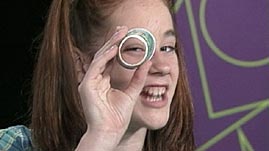Teachers' Domain - Digital Media for the Classroom and Professional Development
User: Preview


Source: ZOOM
Columns: Experimenting with Paper Cups (Document)
(humming) (gasps) Ooh!
KALEIGH: Mrs. Caballero's second-grade class, in Brookline, Massachusetts, challenged us to use these paper cups and this piece of cardboard to make a platform that's strong enough to support a weight of a person.
GARRETT: If I stand on a cup... it'll get smooshed.
ALL: (laughing)
GARRETT: That's because all of my weight is pushing, or compressing, this one cup.
CAROLINE: When we arrange the cups like this and put the cardboard on top, each cup supported less weight, and there wasn't too much weight on any one cup.
KALEIGH: Ready, Garrett? Yahoo. (chuckling) We still have a few questions, like, do the cups need to have bottoms to make this work?
CAROLINE: Here's what we found out.
ALL: (yelling)
CAROLINE: We wanted the cups to support our weight without any bottoms, so we needed to change something about the cups to make them stronger. We learned that the bottoms of the cups keep the sides apart and keep the cups from smooshing in.
KALEIGH: So if we add sand to the cups without any bottoms in it, the sand would push on the sides of the cup and keep the cup sides from smooshing in. So make that ten—the circle out of nine, and then one in the middle. Ready?
CAROLINE: I bet this will be really strong.
KALEIGH: I know, because the bottom... The bottom worked well at holding it up, but the cup was still hollow. The sand—because it fills up all the area in the cup—will be twice as strong as... Where's the cardboard? Okay. Okay. Okay.
GARRET:: Whoa!
KALEIGH: I bet we could even...
GARRET: You want to get on it?
KALEIGH: Me?=
GARRETT: Yeah, go, try it.
KALEIGH: Hey, it works. I'm not stepping on any cups.
GARRETT: That's all right.
(ALL: (screaming playfully)
GARRETT: Here's why the paper cup supported us when we filled it with sand. There are two things going on. The first thing is that the paper is holding the sand in place. See? If I hold the sand in my hand, it spreads all over the place. But when I put the sand in a cup, the sides of the cup prevent the sand from spreading out.
CAROLINE: To spread out, the sand would have to stretch the paper in the cup. Since the paper in the cup is strong, it's able to stop that. See, when I pull the paper like this, it's really strong. It's called "tension."
KALEIGH: But when Caroline pushes on the paper, like that, it folds in on itself. So the sand inside the cup is pushing on the sides of the cup, preventing it from folding in on itself when we push on the cup.
GARRETT: The cups are like the columns of the building and the cardboard is like the roof. When I stand on the cardboard, I put a heavy load, pressing down, on the columns. This is called "compression." The columns become very strong when they are compressed, and they hold me up. Really cool.
KALEIGH: Try to bounce on it.
GARRETT: All right, hold on.
ALL: Whoa!
(bubbling)
 Loading Standards
Loading Standards Teachers' Domain is proud to be a Pathways portal to the National Science Digital Library.
Teachers' Domain is proud to be a Pathways portal to the National Science Digital Library.
